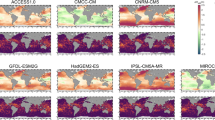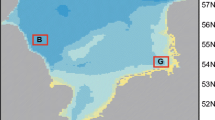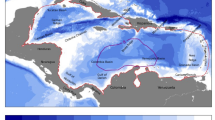Abstract
An analysis of today’s mean and extreme wave conditions in the North Sea and their possible future changes due to anthropogenic climate change are presented. The sea state was simulated for the 30-year period 2071–2100 using the wave model WAM and an ensemble of wind field data sets for four climate change realizations as driving data. The wind field data sets are based on simulation outputs from two global circulation models (GCMs: HadAM3H and ECHAM4/OPYC3) for two emission scenarios (A2 and B2, Intergovernmental Panel on Climate Change, Special Report on Emission Scenarios). They were regionalized by the Swedish Meteorological and Hydrological Institute using the regional climate model RCAO. The effects of the climate realizations on the sea state statistics were assessed by analyzing the differences between the patterns in the four CGM/emission scenario combinations and those in two control simulations representing reference wave climate conditions for the 30-year period 1961–1990. The analysis of the four emission scenario/GCM combinations has shown that the future long-term 99 percentile wind speed and significant wave height increase by up to 7% and 18%, respectively, in the North Sea, except for significant wave height off the English coast and to the north in the HadAM3H-driven simulation. The climate change response in the ECHAM4/OPYC3-forced experiments is generally larger than in the HadAM3H-driven simulations. The differences in future significant wave height between the different combinations are in the same order of magnitude as those between the control runs for the two GCMs. Nevertheless, there is agreement among the four combinations that extreme wave heights may increase in large parts in the southern and eastern North Sea by about 0.25 to 0.35 m (5–8% of present values) towards the end of the twenty first century in case of global warming. All combinations also show an increase in future frequency of severe sea state.
Similar content being viewed by others
References
Alexandersson H, Tuomenvirta H, Schmidth T, Iden K (2000) Trends of storms in NW Europe derived from an updated pressure data set. Clim Res 14:71–73
CPSL (2001) Final report of the Trilateral Working Group on Coastal Protection and Sea Level Rise, Wadden Sea Ecosystem No. 13, Common Wadden Sea Secretariat. Wilhelmshaven, Germany
Debernard J, Røed L (2008) Future wind, wave and storm surge climate in the Northern Seas: a revisit. Tellus 60:427–438. doi:10.1111/j.1600–0870.2008.00312.x
Debernard J, Sætra Ø, Røed L (2002) Future wind, wave and storm surge climate in the Northern Seas. Clim Res 23:39–49
Ferk U (1995) Folgen eines beschleunigten Meeresspiegelanstiegs für die Wattgebiete der niedersächsischen Nordseeküste. Die Küste 57:135–156
Feser F, Weisse R, von Storch H (2001) Multi-decadal atmospheric modeling for Europe yields multi-purpose data. Eos Trans 82:305, 310
Flemming BW, Bartholomä A (1997) Response of the Wadden Sea to a rising sea level: a predictive empirical model. Deutsche Hydrogr Z 49:343–353
Gaslikova L, Weisse R (2006) Estimating near-shore wave statistics from regional hindcasts using downscaling techniques. Ocean Dyn 56:26–35. doi:10.1007/s10236–005–0041–2
Gordon C, Cooper C, Senior CA, Banks H, Gregory JM, Jones TC, Mitchell JFB, Wood RA (2000) The silumation of SST, sea ice extents and ocean heat transports in a version of the hadley centre coupled model without flux adjustments. Clim Dyn 16:147–166
Günther H, Rosenthal W, Stawarz M, Carretero J, Gomez M, Lozano I, Serrano O, Reistad M (1998) The wave climate of the Northeast Atlantic over the period 1955–1994: the WASA wave hindcast. Global Atmos Ocean Syst 6:121–164
Hofstede J (1999) Mögliche Auswirkungen eines Klimawandels im Wattenmeer. Petermanns Geogr Mitt 143:305–314
Houghton J, Ding Y, Griggs D, Noguer M, van der Linden P, Dai X, Maskell K, Johnson C (eds) (2001) Climate change 2001: The scientific basis. Contribution of Working Group I to the Third Assessment Report of the Intergovernmental Panel on Climate Change. Cambridge University Press, New York
Jones C, Ullerstig A, Willén U, Hansson U (2004) The Rossby Centre regional atmospheric climate model (RCA). Part I: model climatology and performance characteristics for present climate over Europe. Ambio 33:199–210
Nakicenovic N, Swart R (eds) (2000) Special Report of the Intergovernmental Panel on Climate Change on Emission Scenarios. Cambridge University Press, Cambridge. Summary available online at http://www.ipcc.ch/pub/reports.htm
Niemeyer HD, Kaiser R (1999) Seegang. In: Nationalparkverwaltung Niedersächsisches Wattenmeer & Umweltbundesamt (ed) Umweltatlas Wattenmeer - Band 2 Ulmer, pp 28–29
Pryor S, Schoof J, Barthelmie R (2006) Winds of change? Projections of near-surface winds under climate change scenarios. Geophys Res Lett 33:L11702. doi:10.1029/2006/GL026000
Räisänen J, Hansson U, Ullerstig A, Döscher R, Graham LP, Jones C, Meier M, Samuelsson P, Willén U (2003) GCM driven simulations of recent and future climate with the Rossby Centre coupled atmosphere—Baltic Sea regional climate model RCAO. SMHI Reports Meteorology and Climatology 101. Available from SMHI, S-60176 Norrköpingm Sweden, 61 pp
Räisänen J, Hansson U, Ullerstig A, Döscher R, Graham LP, Jones C, Meier HEM, Samuelsson P, Willén U (2004) European climate in the late twenty-first century: regional simulations with two driving global models and two forcing scenarios. Clim Dyn 22:13–31. doi:10.1007/s00382–003–0365–x
Roeckner E, Bengtsson L, Feichter J, Lelieveld, Rodhe H (1999) Transient climate change simulations with a coupled atmosphere-ocean GCM including the trophospheric sulfur cycle. J Climate 12:3004–3032
Rummukainen M, Räisäsen J, Bringfelt B, Ullerstig A, Omstedt A, Willén U, Hansson U, Jones C (2001) A regional climate model for northern europe: model description and results from the downscaling of two GCM control simulations. Clim Dyn 17:339–359
STOWASUS-Group (2001) Synthesis of the STOWASUS-2100 project: regional storm, wave and surge scenarios for the 2100 century, Report 01-3. Danish Climate Centre. http://www.dmi.dk/pub/stowasus-2100
WAMDI-Group (1988) The WAM model—a third generation ocean wave prediction model. J Phys Oceanogr 18:1776–1810
Wang X, Swail V (2004) Historical and possible future changes of wave heights in northern hemisphere oceans. In: Perrie W (ed) Atmosphere ocean interactions, vol 2. Wessex Institute of Technology Press, Ashurst
Wang X, Swail V (2006) Climate change signal and uncertainty in projections of ocean wave heights. Clim Dyn 26:109–126. doi:10.1007/s00382–005–0080–x
Wang X, Zwiers F, Swail V (2004) North Atlantic ocean wave climate change scenarios for the twenthy-first century. J Climate 17:2368–2383
WASA-Group (1998) Changing waves and storms in the Northeast Atlantic? Bull Am Meteorol Soc 79:741–760
Weisse R, Feser F (2003) Evaluation of a method to reduce uncertainty in wind hindcasts performed with regional atmosphere models. Coast Eng 48:211–225
Weisse R, Günther H (2007) Wave climate and long-term changes for the Southern North Sea obtained from high-resolution hindcast 1958–2002. Ocean Dyn 57:161–172. doi:10.1007/s10236–006–0094–x
Weisse R, von Storch H, Feser F (2005) Northeast Atlantic and North Sea storminess as simulated by a regional climate model 1958-2001 and comparison with observations. J Climate 18:465–479. doi:10.1175/JCLI–3281.1
Wittig S, Elsner A, Elsner W, Eppel DP, Grabemann I, Grabemann HJ, Kraft D, Mai S, Meyer V, Otte C, Schirmer M, Schuchardt B, Zimmermann C (2007) Der beschleunigte Meeresspiegelanstieg und die Küstenschutzsysteme: Ergebnisse der erweiterten Risikoanalyse. In: Schuchardt B, Schirmer M (eds) Land unter? Klimawandel, Küstenschutz und Risikomanagement in Nordwestdeutschland: die Perspektive 2050, Oekom Verlag, pp 93–113
Woth K (2005) North Sea storm surge statistics based on projections in a warmer climate: how important are the driving GCM and the chosen emission scenario? Geophys Res Lett 32:L22708. doi:10.1029/2005GL023762
Woth K, Weisse R, von Storch H (2006) Climate change and North Sea storm surge extremes: an ensemble study of storm surge extremes expected in a changed climate projected by four different regional climate models. Ocean Dyn 56:3–15. doi:10.1007/s10236–005–0024–3
Author information
Authors and Affiliations
Corresponding author
Additional information
Responsible Editor: Jörg-Olaf Wolff
Rights and permissions
About this article
Cite this article
Grabemann, I., Weisse, R. Climate change impact on extreme wave conditions in the North Sea: an ensemble study. Ocean Dynamics 58, 199–212 (2008). https://doi.org/10.1007/s10236-008-0141-x
Received:
Accepted:
Published:
Issue Date:
DOI: https://doi.org/10.1007/s10236-008-0141-x




